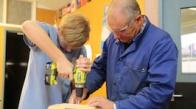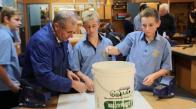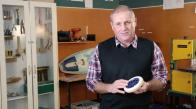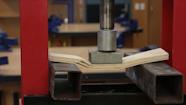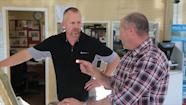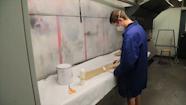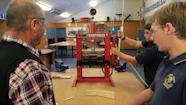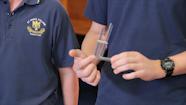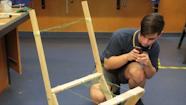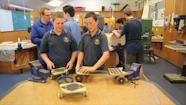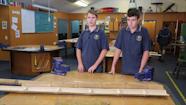Year 12 students from St John's College describe what they know about bamboo and how they are applying this knowledge to their projects.
Exploring unfamiliar materials
Transcript
Student 1: The process we went through to get the bamboo was, first, we had to go basically cut it down.
Student 2: And we’ve bought it into school and we’re just mucking around with it at the moment.
Student 1: Originally, it was that we got big pieces like this, this one here. So we bought it back to school and then we realised that it actually was too green to be used. So then what we did with Mr Andrews was we, first we cut it into lengths. So we cut it down the middle, and then what we did is we developed a drying oven to actually put the bamboo in the drying oven and dry it out. Otherwise, it would take six, about six months to naturally dry out.
Student 2: We’ve cut them into thinner strips and then put them through the thicknesser, and that’s how we got sort of flat strips like this. We knew what sort of equipment and tools to use because we’d done stuff before with other materials from previous years and projects. So we sort of just applied our knowledge of timbers to the bamboo.
Student 1: So what we’ve found out from the bamboo so far is that it can be machined as is shown here. It can be put through machines, it can be cut, it can be dried out, which is in a faster way than what it naturally is. And we also found out through testing that the bamboo flexes more this way than what it does this way. And it’s stronger this way. So you can see you can actually bend it right around until it breaks, until about ... breaks properly (it’s actually quite strong this one) like that. And then this way it’s a lot harder, and it splits like that.
The way I’m going to apply it to my project is the part that is stronger is going to go on the top of my board. So if I was to use bamboo, it would be this part here because it’s stronger and so it will make my project overall stronger and it won’t snap or break.
Student 2: The main force on my board is going to be downwards force and drag from the water, and so the bamboo is going to have to go this way on the bottom because that’s the way it flexes and it’s stronger this way. And yeah, and so it’s going to stand up to the forces that are applied onto it. And so it’s going to compress down and expand on the bottom without breaking.
Related videos
Combining knowledge and practice (01:58)
Steve Andrew explains how understanding materials is essential for effective technological practice.
Linking hands-on experiences and understandings (03:54)
Hands-on experiences allow the students to see materials understandings in action.
Play, experiment, explore (02:55)
Steve Andrew lets the students see, feel, and play with products to develop their understandings in materials.
Finding materials to meet the specs (02:36)
Steve Andrew shares how students identify material specifications in a brief and then test materials to find those that are suitable....
School–industry relationship cuts both ways (03:36)
Steve Andrew and Terry Rillstone describe the way the relationship between St John's College and The Shop has benefits for them both....
Pushing the boundaries with materials (02:53)
Steve Andrew describes how his senior students have the confidence to select and work with unfamiliar materials.
Students and teachers talk about testing materials in year 11.
Manipulating, forming, and transforming
Students in year 10 describe manipulating, forming, and transforming materials.
Evaluating materials for an outcome
Steve Andrew and students talk about using their knowledge to test materials for their projects at year 12.
Year 10 students describe some of the attributes for the snake skates they are developing.
Senior students select their own issues
Year 12 students talk about the issues that they have selected for their projects.

